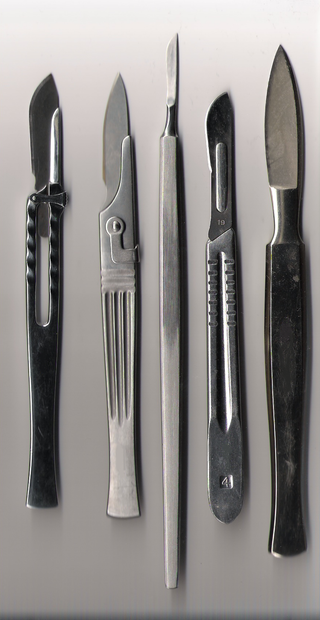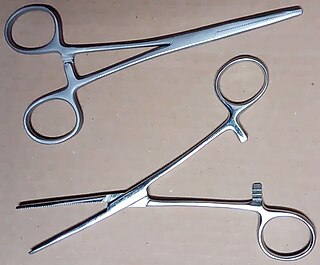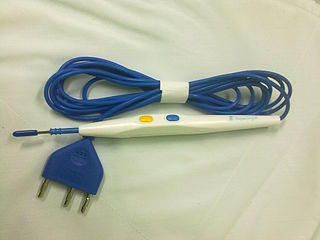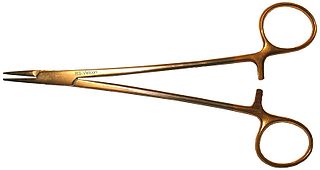
Scissors are hand-operated shearing tools. A pair of scissors consists of a pair of blades pivoted so that the sharpened edges slide against each other when the handles (bows) opposite to the pivot are closed. Scissors are used for cutting various thin materials, such as paper, cardboard, metal foil, cloth, rope, and wire. A large variety of scissors and shears all exist for specialized purposes. Hair-cutting shears and kitchen shears are functionally equivalent to scissors, but the larger implements tend to be called shears. Hair-cutting shears have specific blade angles ideal for cutting hair. Using the incorrect type of scissors to cut hair will result in increased damage or split ends, or both, by breaking the hair. Kitchen shears, also known as kitchen scissors, are intended for cutting and trimming foods such as meats.

A scalpel, lancet, or bistoury is a small and extremely sharp bladed instrument used for surgery, anatomical dissection, podiatry and various handicrafts. A lancet is a double-edged scalpel.

A hemostat is a tool used to control bleeding during surgery. Similar in design to both pliers and scissors, it is used to clamp exposed blood vessels shut.

Forceps are a handheld, hinged instrument used for grasping and holding objects. Forceps are used when fingers are too large to grasp small objects or when many objects need to be held at one time while the hands are used to perform a task. The term "forceps" is used almost exclusively in the fields of biology and medicine. Outside biology and medicine, people usually refer to forceps as tweezers, tongs, pliers, clips or clamps.

Tweezers are small hand tools used for grasping objects too small to be easily handled with the human fingers. Tweezers are thumb-driven forceps most likely derived from tongs used to grab or hold hot objects since the dawn of recorded history. In a scientific or medical context, they are normally referred to as just "forceps", a name that is used together with other grasping surgical instruments that resemble pliers, pincers and scissors-like clamps.

A surgical instrument is a medical device for performing specific actions or carrying out desired effects during a surgery or operation, such as modifying biological tissue, or to provide access for viewing it. Over time, many different kinds of surgical instruments and tools have been invented. Some surgical instruments are designed for general use in all sorts of surgeries, while others are designed for only certain specialties or specific procedures.
A Pennington clamp, also known as a Duval clamp, is a surgical clamp with a triangular eyelet. Used for grasping tissue, particularly during intestinal and rectal operations. Also used in some OB/GYN procedures, particularly caesarian section. Under the name 'Duval clamp' they are occasionally used much like a Foerster clamp to atraumatically grasp lung tissue. The clamp is named after David Geoffrey Pennington, an Australian surgeon who is a pioneer of microsurgeries.

Trauma shears, also known as Tuff Cuts, are a type of scissors used by paramedics and other emergency medical personnel to quickly and safely cut clothing from injured people. They usually consist of a plastic handle with a metal blade, which is traditionally bent at about 150 degrees, giving them an unusual appearance as compared to normal scissors, and also a longer lever arm.

There are many different surgical specialties, some of which require very specific kinds of surgical instruments to perform.

A needle holder, also called needle driver or needle forceps, is a surgical instrument similar to a hemostat, used by doctors and surgeons to hold and push a suturing needle when performing wound closure, ligation and other surgical procedures that require re-anastomosis.

Metzenbaum scissors are surgical scissors designed for cutting delicate tissue and blunt dissection. The scissors come in variable lengths and have a relatively high shank-to-blade ratio. They are constructed of stainless steel and may have tungsten carbide cutting surface inserts. The blades can be curved or straight, and the tips are usually blunt. This is the most common type of scissors used in organ-related operations.

A surgical suture, also known as a stitch or stitches, is a medical device used to hold body tissues together and approximate wound edges after an injury or surgery. Application generally involves using a needle with an attached length of thread. There are numerous types of suture which differ by needle shape and size as well as thread material and characteristics. Selection of surgical suture should be determined by the characteristics and location of the wound or the specific body tissues being approximated.

Bandage scissors, or bandage forceps, are scissors that often have an angled tip with a blunt tip on the bottom blade. This helps in cutting bandages without gouging the skin. Lister bandage scissors and utility bandage scissors exhibit the well known angle, while Knowles bandage scissors have blades that are either straight or curved.

The following is a list of instruments that are used in modern obstetrics and gynaecology.

Tenotomy scissors are surgical scissors used to perform delicate surgery. They can be straight or curved, and blunt or sharp, depending upon necessity. This equipment can be used in many surgical specialties, in particular delicate operations in ophthalmic surgery, oral and maxillofacial surgery, or in neurosurgery.

Mayo scissors are a type of surgical scissor, often used in the cutting of fascia.
Iris scissors are a type of scissors with short blades that was originally developed for ophthalmic surgery. They are alternatively referred to as Iris forceps in the United Kingdom and Asia. Iris scissors are also available in the crafting market and are sometimes used for the production of fabric-related goods. Both closed and open shank versions are available.

Circumcision surgical procedure in males involves either a conventional "cut and stitch" surgical procedure or use of a circumcision instrument or device. In the newborn period, almost all circumcisions are done by generalist practitioners using one of three surgical instruments. In the US, the Gomco clamp is the most utilized instrument, followed by the Mogen clamp and the Plastibell. They are also used worldwide.

Ancient Roman surgical practices developed from Greek techniques. Roman surgeons and doctors usually learned through apprenticeships or studying. Ancient Roman doctors such as Galen and Celsus described Roman surgical techniques in their medical literature, such as De Medicina. These methods encompassed modern oral surgery, cosmetic surgery, sutures, ligatures, amputations, tonsillectomies, mastectomies, cataract surgeries, lithotomies, hernia repair, gynecology, neurosurgery, and others. Surgery was a rare practice, as it was dangerous and often had fatal results. To perform these procedures, they used tools such as specula, catheters, enemas, bone levers, osteotomes, phlebotomes, probes, curettes, bone drills, bone forceps, cupping vessels, knives, scalpels, scissors, and spathas.



















